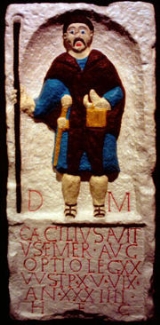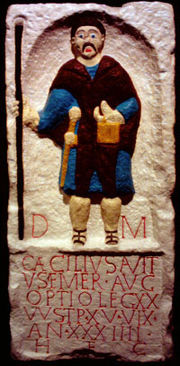
Roman military tombstones
Encyclopedia
The archaeology of death in the Roman period provides great detail into the lives and practices of the Imperial Roman army
.
Military tombstones are most commonly from the 1st and 2nd Centuries AD; the pre-Marian army used soldiers for specific campaigning periods who would return to civilian after serving Rome. The longer terms of service installed in the late 1st Century BC provides a greater body of evidence
 The Latin inscriptions on such tombstones can provide details on several aspects of life in the Roman army
The Latin inscriptions on such tombstones can provide details on several aspects of life in the Roman army
including:
Age - Through the Latin 'ANNORUM', an age at death is often provided like in modern headstones. Of a sample of 531 tombstones from the Roman period it was found that a trend exists whereby the age at death is rounded to the nearest 5 or 10, but this is not a uniform pattern
Enlistment- Vegetius argues that enlistment occurs upon entering puberty, but Scheidel's sample discovered that around 50% of the tombstones showed enlistment occurring between ages 17–20, with an increase to 80% if ages 17–24 are included. There are also 5 examples of enlistment between ages 33–36 and one example at age 13.
Rank - Rank is an important factor in the Roman Army
and one that is clearly visible in death. Examples exist showing the rank and file of the legions and auxiliary units, but also of centurions, standard-bearers, bene ficarii – units attached to the legatus
's bodyguard and armourers,
One of the most famous tombstones from the Roman
world is one of a centurion named Marcus Caelius. The inscription reads thus:
M[arco] CAELIO T[iti] F[ilio] LEM[onia tribv] BON[onia]
I O[rdinis] LEG[ionis] XIIX ANN[orvm] LIIIS
OCCIDIT BELLO VARIANO OSSA
INFERRE LICEBIT P[vblivs] CAELIVS T[iti] F[ilivs]
LEM[onia tribv] FRATER FECIT
The tombstone of Marcus Caelius, is a particularly well known and ornate example of a legionary
tombstone. He is shown in a deep set relief, flanked by busts of his freedmen, underneath a classical colonnade
and pediment
. He holds the vitis, the cane held by a centurion
and can be seen to wear the crown of oak – a symbol that he has saved another's life at some point.
Imperial Roman army
The Imperial Roman army refers to the armed forces deployed by the Roman Empire during the Principate era .Under the founder–emperor Augustus , the legions, which were formations numbering about 5,000 heavy infantry recruited from Roman citizens only, were transformed from a mixed conscript and...
.
Tombstone form
The most familiar form of commemoration in death is the standing stone stelae; stone slabs taller than they are wide upon which they are inscribed with simple commemorative epitaphs. This may simply include a bordered written inscription, or one with added iconography of the deceased.Military tombstones are most commonly from the 1st and 2nd Centuries AD; the pre-Marian army used soldiers for specific campaigning periods who would return to civilian after serving Rome. The longer terms of service installed in the late 1st Century BC provides a greater body of evidence
Epigraphic style

Roman army
The Roman army is the generic term for the terrestrial armed forces deployed by the kingdom of Rome , the Roman Republic , the Roman Empire and its successor, the Byzantine empire...
including:
Age - Through the Latin 'ANNORUM', an age at death is often provided like in modern headstones. Of a sample of 531 tombstones from the Roman period it was found that a trend exists whereby the age at death is rounded to the nearest 5 or 10, but this is not a uniform pattern
Enlistment- Vegetius argues that enlistment occurs upon entering puberty, but Scheidel's sample discovered that around 50% of the tombstones showed enlistment occurring between ages 17–20, with an increase to 80% if ages 17–24 are included. There are also 5 examples of enlistment between ages 33–36 and one example at age 13.
Rank - Rank is an important factor in the Roman Army
Roman army
The Roman army is the generic term for the terrestrial armed forces deployed by the kingdom of Rome , the Roman Republic , the Roman Empire and its successor, the Byzantine empire...
and one that is clearly visible in death. Examples exist showing the rank and file of the legions and auxiliary units, but also of centurions, standard-bearers, bene ficarii – units attached to the legatus
Legatus
A legatus was a general in the Roman army, equivalent to a modern general officer. Being of senatorial rank, his immediate superior was the dux, and he outranked all military tribunes...
's bodyguard and armourers,
One of the most famous tombstones from the Roman
Ancient Rome
Ancient Rome was a thriving civilization that grew on the Italian Peninsula as early as the 8th century BC. Located along the Mediterranean Sea and centered on the city of Rome, it expanded to one of the largest empires in the ancient world....
world is one of a centurion named Marcus Caelius. The inscription reads thus:
M[arco] CAELIO T[iti] F[ilio] LEM[onia tribv] BON[onia]
I O[rdinis] LEG[ionis] XIIX ANN[orvm] LIIIS
OCCIDIT BELLO VARIANO OSSA
INFERRE LICEBIT P[vblivs] CAELIVS T[iti] F[ilivs]
LEM[onia tribv] FRATER FECIT
To Marcus Caelius, son of Titus, of the Lemonian district, from
Bologna, first centurion of the eighteenth legion. 53½ years old.
He fell in the Varian War. His bones
may be interred here. Publius Caelius, son of Titus,
of the Lemonian district, his brother, erected (this monument).
Iconographic style
The visual representation above the Latin inscription is important indeed as it provides an image of how the deceased has been immortalised in death. Several tombstones of auxiliary cavalrymen depict them in a killing-scene, riding high over a defeated (usually Gallic styled) foe. A recent discovery, in 2007 depicts a cavalryman stationed in Britain called Insus. Instead of a relief showing him mid-kill, Insus rides tall over a prone enemy whilst holding the severed head of his victim in a victorious pose.The tombstone of Marcus Caelius, is a particularly well known and ornate example of a legionary
Legionary
The Roman legionary was a professional soldier of the Roman army after the Marian reforms of 107 BC. Legionaries had to be Roman citizens under the age of 45. They enlisted in a legion for twenty-five years of service, a change from the early practice of enlisting only for a campaign...
tombstone. He is shown in a deep set relief, flanked by busts of his freedmen, underneath a classical colonnade
Colonnade
In classical architecture, a colonnade denotes a long sequence of columns joined by their entablature, often free-standing, or part of a building....
and pediment
Pediment
A pediment is a classical architectural element consisting of the triangular section found above the horizontal structure , typically supported by columns. The gable end of the pediment is surrounded by the cornice moulding...
. He holds the vitis, the cane held by a centurion
Centurion
A centurion was a professional officer of the Roman army .Centurion may also refer to:-Military:* Centurion tank, British battle tank* HMS Centurion, name of several ships and a shore base of the British Royal Navy...
and can be seen to wear the crown of oak – a symbol that he has saved another's life at some point.

